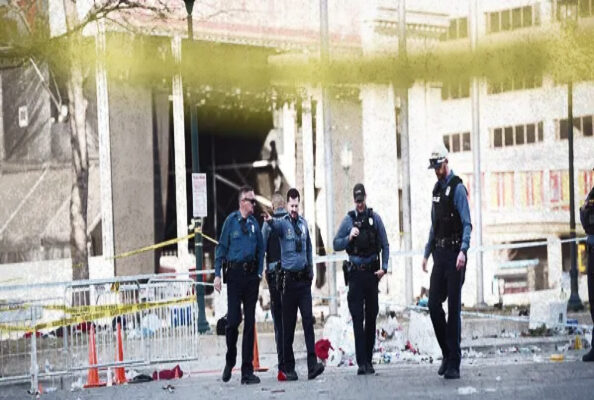“It cannot get worse, right? They will come to their senses, won’t they?” These are the laments of normies watching the disorder in cities and rising crime across America. Sorry, but there are structural reasons it will get worse. Our cities are Democrat citadels, and over a dozen states are Democrat strongholds. The Democratic Party in the United States has undergone significant transformations in its voter base over the past few decades, leading to a new landscape where policy positions, particularly on issues like crime and justice, require careful consideration. By careful consideration, I mean shrugs and deflections about no worse than 1991 (the super-predator era for those who remember). While the tough-on-crime stance was once a hallmark of the Clinton era, triangulation politics, shifts in demographics, social attitudes, and party priorities have made a return to such policies increasingly challenging.
One of the primary factors complicating the Democratic Party’s return to tough-on-crime policies is the shifting demographics of its voter base. Historically, the party enjoyed strong support from working-class and middle-class White voters, particularly in urban areas where crime rates were often higher. You know the score. The composition of the Democratic electorate has become more diverse, with increasing numbers of African American, Hispanic, and younger voters who are subject to law-and-order policing policies and strict sentencing policies firsthand (because they commit crime at higher rates). As a result, there is growing resistance within the party to measures that are perceived as disproportionately targeting minority communities. The framing is that they target these communities rather than just react to the actual crimes committed.
In addition to demographic changes, evolving social attitudes towards crime and punishment have played a significant role in shaping Democratic policy priorities. The era of mass incarceration and draconian sentencing laws in the late 20th century has given way to a broader consensus that emphasizes rehabilitation, restorative justice, and addressing the root causes of crime. There is a generation of voters that grew up after the mid-20th century crime wave and only know the relatively calmer era that was the product of tough on crime ‘90s laws. Grassroots movements such as Black Lives Matter have amplified calls for police accountability and reform, pushing the party further away from punitive approaches to criminal justice. As the black vote is a sizeable chunk of Democrats’ total votes and important for multiple swing states, any pivot to a tougher approach to crime is dead on arrival. Consequently, Democratic politicians face pressure from within their own ranks to adopt more progressive policies that prioritize equity and fairness over tough-on-crime rhetoric. Equity and fairness in this context means not arresting, catch and release and letting criminals out on the streets.
Furthermore, the Democratic Party’s strategic imperatives have evolved in response to changing electoral dynamics. With the rise of suburban voters as a crucial demographic battleground, particularly in swing states, Democratic candidates must navigate a delicate balance between appealing to progressive urban constituencies and moderate suburbanites. Discarding tough-on-crime policies risks alienating the latter group, many of whom prioritize issues such as public safety and law enforcement. Consequently, Democratic leaders may hesitate to endorse measures that could actually expand their electoral coalition and jeopardize their prospects in competitive races just because the core base is now so pro-criminal.
The complexities of navigating the Democratic Party’s diverse voter base and competing priorities are evident in the dynamics of the 2024 election cycle. In key races across the country, Democratic candidates find themselves grappling with how to address crime and public safety concerns while remaining faithful to the party’s core principles. Core principles have changed to reflect the new coalition, so we shall see how firm they are. There will always be a call to attack underlying socioeconomic factors contributing to crime (more government social spending), while others may emphasize community policing and diversion programs as alternatives to incarceration (will not work but sounds nicer). The problem remains that any move towards a return to tough-on-crime policies risks backlash from progressive activists and minority communities, highlighting the delicate balancing act facing Democratic politicians in an increasingly polarized political landscape. As a result of the growing non-White vote on the Left, there is deep-seated resistance within the Democratic base regarding the effectiveness and fairness of punitive approaches to crime.
This still runs into the issue of ideology. Many Democratic voters prioritize social justice and equity (even when they cannot define it), viewing the criminal justice system as fundamentally flawed and in need of reform. In their view, reform just means no jails and handing out money. There is a growing recognition among Democrats that incarceration alone does little to address the underlying issues driving criminal behavior because they refuse to believe that removing criminals from the streets reduces crime. Study after study shows recidivism is the biggest issue, so why not reduce crime simply by keeping criminals off the streets? This simple idea is beyond the pale. Instead, there is greater support for rehabilitation programs, mental health services, and alternatives to incarceration that focus on reintegrating offenders into society and reducing recidivism rates. Keep in mind Ryan Carson’s killer was in a job placement program and being paid for a do-nothing job.
The major issue is the Democratic Party has embraced progressive policy priorities, including criminal justice reform, police accountability, and investments in social programs over any practical approach. They are divorced from reality. Advocating for tougher sentences for violent criminals is perceived as contradictory to these broader goals and could undermine the party’s commitment to progressive values despite the rising criminality in their own neighborhoods.
The ‘90s tough-on-crime pivot, after decades of dealing with the Warren Court tsunami, was only possible because the Democrats needed more White voters who were persuadable or elastic, as Nate Silver calls them. The voter pool was more open to practical policies. The changing composition of the Democratic Party’s voter base, coupled with their pro-crime ideology, presents significant obstacles to a return to tough-on-crime policies. While the party may grapple with how best to address crime and public safety concerns, it is clear that any such efforts will be blocked by the reliance on demographics who have higher rates of crime within the Democratic coalition and the ideological handcuffs the progressive wing places on politicians. There is no going back for those locations. The best one can hope for is that red and purple states can do something to stymie the drift of their metros into pro-crime sanctuary cities.
-By Fred Watson Jr

Visit The American Sun at The American Sun






Oy gevalt! This site has become a hotbed of baseless anti-Semitic canards!
Why do I call them, “baseless anti-Semitic canards”?
Obviously because they are baseless anti-Semitic canards.
The author actually thinks that there are two legitimate parties, and that voting is a real, actual thing. Is it cognitive dissonance, or more of the ubiquitous controlled opposition to hypnotize the masses? Oh, my head so hurts.
Stay out of the cities, and as Phil Robertson said, ‘I don’t call 9-1-1. I am 9-1-1.!’